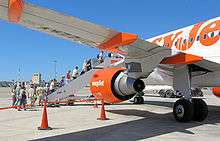Commercial aviation

Commercial aviation is the part of civil aviation (both general aviation and scheduled airline services) that involves operating aircraft for hire to transport passengers or multiple loads of cargo.
History
Origins
The Air Commerce Act of 1926 began to regularize commercial aviation by establishing standards, facilitation, and promotion. An Aeronautical Branch was established in the Department of Commerce with William P. MacCracken, Jr. as director. To promote commercial aviation, he told town fathers that "Communities without airports would be communities without airmail."
Writing for Collier's in 1929, he noted "Commercial aviation is the first industry inspired by hero-worship and built upon heros". He cited the promotion in South America by Herbert Dargue in early 1927. After his trans-Atlantic flight, Charles Lindbergh made a tour of the 48 States paid for by the Guggenheim Foundation for the Promotion of Aeronautics. From that point commercial aviation took off:
- Roads were chocked on Sundays for weeks afterward, by motorists trying to get to Lambert Field, Lindbergh’s home port in Saint Louis, to buy their first air hop. Hundreds of thousands of you went aloft for the first time that summer.”[1]
The Aeronautical Branch was charged with issuing commercial pilot licenses, airworthiness certificates, and with investigating air accidents.[2]
Post-war aviation

After World War II, commercial aviation grew rapidly, using mostly ex-military aircraft to transport people and cargo. The experience used in designing heavy bombers such as the B-29 and Avro Lancaster could be used for designing heavy commercial aircraft. The DC-3 also made for easier and longer commercial flights. The first commercial jet airliner to fly was the British de Havilland Comet. By 1952, the British state airline BOAC had introduced the Comet into scheduled service. While a technical achievement, the plane suffered a series of highly public failures, as the shape of the windows led to cracks due to metal fatigue. The fatigue was caused by cycles of pressurization and depressurization of the cabin, and eventually led to catastrophic failure of the plane's fuselage. By the time the problems were overcome, other jet airliner designs had already taken to the skies.
See also
- Airliner
- Direct flight
- Domestic flight
- Environmental impact of aviation (including effects on climate change)
- International flight
- Mainline
- Non-stop flight
- Private aviation
- Peak oil
References
- ↑ William P. MacCracken, Jr. (December 21, 1929) "Its Hard to get You Up", Collier's
- ↑ The First Federal Regulator for Aviation from Federal Aviation Administration